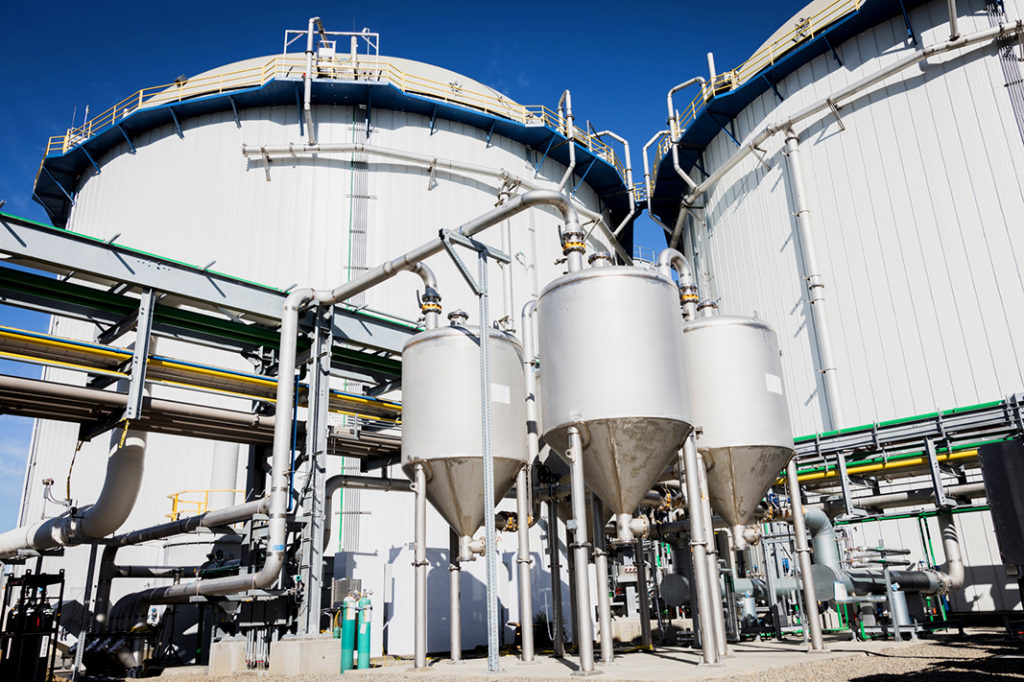Top: SoCalGas fueling station that dispenses RNG.

One of the projects putting RNG into the SoCalGas pipeline is the Rialto Bioenergy Facility, an anaerobic digestion plant developed by Anaergia, Inc. Photo courtesy SoCalGas
In late February, the California Public Utilities Commission (CPUC) set biomethane procurement targets for utilities to reduce short-lived climate pollutant (SLCP) emissions. The decision establishes a biomethane procurement program crafted to help achieve the state’s goals that require the reduction of emissions of methane and other SLCPs by 40% below 2013 levels by 2030. “Renewable gas procurement will reduce otherwise uncontrolled methane and black carbon emissions in our waste, landfill, agricultural and forest management sectors,” noted the CPUC in its announcement of the procurement targets. It cites 2019 California Air Resources Board data that identified those sectors being responsible for more than 75% of the state’s methane emissions.
The policy action was prompted by Senate Bill 1440 (Hueso, 2018), which authorized the CPUC to adopt biomethane procurement targets or goals for the gas utilities it regulates, and Senate Bill 1383 (Lara, 2014), which established the SLCP reduction requirements. The biomethane — also known as renewable natural gas (RNG) — will displace some of the fossil fuel natural gas that utilities supply to their customers. The CPUC’s decision establishes two primary procurement goals:
- The short-term 2025 biomethane procurement target is 17.6 billion cubic feet of biomethane, which corresponds to 8 million tons of organic waste diverted annually from landfills. Each utility will be responsible for procuring a percentage of the total in accordance with its proportionate share of natural gas deliveries.
- The medium-term 2030 target for biomethane procurement is 72.8 billion cubic feet annually. This higher amount will help the state achieve its goal to reduce methane emissions by 40% by 2030. It reflects approximately 12% of current residential and small business (known as “core gas customers”) gas usage in 2020.
- Because biomethane from dairies is currently incentivized in other state programs, under the decision it may be procured to satisfy only the medium-term target, after the utility has procured sufficient biomethane from organic waste diverted from landfills to divert its share of 8 million tons of organic waste. For the medium-term goal, there is a ceiling on dairy biomethane of 4% of total biomethane procurement. Measures are required to avoid adverse environmental impacts to air and water quality from any dairies that provide biomethane.
For Southern California Gas Co. (SoCalGas), the largest gas distribution utility in the U.S., the new renewable gas standard requires it to replace 12.2% of the traditional gas it delivers to core customers with renewable gas by 2030. The standard also sets an interim goal of procuring approximately 3% renewable gas by 2025. In 2021, 14 billion cubic feet of RNG produced from organic waste was distributed via SoCalGas’ pipeline system, according to the utility — an increase from the 12 billion cubic feet distributed by SoCalGas in 2020. One of the projects that came on line in 2021 is the Rialto Bioenergy Facility, an anaerobic digestion plant developed by Anaergia, Inc. The facility has the capacity to convert up to 300,000 tons/year of organic waste and biosolids from municipal wastewater treatment facilities and generate up to 985,000 MMBTU/year of RNG, according to Anaergia.
SoCalGas now has nine RNG facilities connected to its gas system. Last year, the utility set a goal to achieve net zero greenhouse gas emissions in its operations and the energy it delivers by 2045. California’s new RNG standard “aligns with and will assist SoCalGas in reaching that goal,” notes the company.













